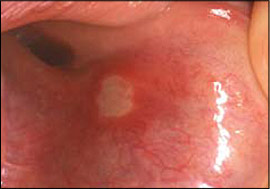Aphthous Stomatitis Causes, Symptoms, Diagnosis and Treatment

What Is Aphthous Stomatitis?
Aphthous stomatitis is a common condition characterized by the repeated formation of benign and non-contagious mouth ulcers (aphthae) in otherwise healthy individuals.
There Are Two Types Of Aphthous Stomatitis:
- Simple Aphthous stomatitis.
These may appear three or four times a year and last up to a week. They typically occur in people between 10 and 20 years of age.
- Complex Aphthous stomatitis.
These are less common and occur more often in people who have previously had them.
These ulcers occur periodically and heal completely between attacks. In the majority of cases, the individual ulcers last about 7–10 days, and ulceration episodes occur 3–6 times per year.
There is no cure, and treatments aim to manage pain, reduce healing time and reduce the frequency of episodes of ulceration.
Causes Of Aphthous Stomatitis:
The underlying cause of Aphthous stomatitis remains unknown.
Possible triggers for Aphthous stomatitis include:
- A minor injury to the mouth from dental work, overzealous brushing, sports mishaps or an accidental cheek bite
- Toothpastes and mouth rinses containing sodium lauryl sulfate
- Food sensitivities, particularly to chocolate, coffee, strawberries, eggs, nuts, cheese, and spicy or acidic foods
- A diet lacking in vitamin B-12, zinc, folate (folic acid) or iron
- An allergic response to certain bacteria in the mouth
- Helicobacter pylori
- Hormonal shifts during menstruation
- Emotional stress
Certain diseases may also lead to the development of Aphthous Stomatitis. They include:
- Celiac disease, a serious intestinal disorder caused by a sensitivity to gluten, a protein found in most grains
- Inflammatory bowel diseases
Crohn’s disease
ulcerative colitis
- Behcet’s disease, a rare disorder that causes inflammation throughout the body, including the mouth
- A faulty immune system that attacks healthy cells in the mouth instead of pathogens, such as viruses and bacteria
- HIV/AIDS, which suppresses the immune system
Aphthous stomatitis is more common in females than males and tends to develop to teens and young adults.
Symptoms Of Aphthous Stomatitis:
Most Aphthous stomatitis is round or oval with a white or yellow center and a red border.
There are several types of Aphthous stomatitis, including minor, major and herpetiform sores.
- Minor Aphthous stomatitis
Minor Aphthous stomatitis is the most common and:
- Are usually small
- Are oval shaped with a red edge
- Heal without scarring in one to two weeks
- Major Aphthous stomatitis
Major Aphthous stomatitis is less common and:
- Are larger and deeper than minor Aphthous stomatitis
- Are usually round with defined borders, but may have irregular edges when very large
- Can be extremely painful
- May take up to six weeks to heal and can leave extensive scarring
- Herpetiform Aphthous stomatitis
These Aphthous stomatitis:
- Are pinpoint size
- Often occur in clusters of 10 to 100 sores, but may merge into one large ulcer
- Have irregular edges
- Heal without scarring in one to two weeks
Diagnosis Of Aphthous Stomatitis:
Aphthous stomatitis can be diagnosed via physical examination of the mouth.
Biopsy may be done to find other possible causes of mouth ulcer.
Treatment Of Aphthous Stomatitis:
Treatment is not required for mild cases.
For severe cases, the following treatment options are available:
- Mouth rinse containing the steroid dexamethasone to reduce pain and inflammation or lidocaine to reduce pain.
- Benzocaine
- Fluocinonide
- Hydrogen peroxide
- Oral medications
By : Natural Health News




